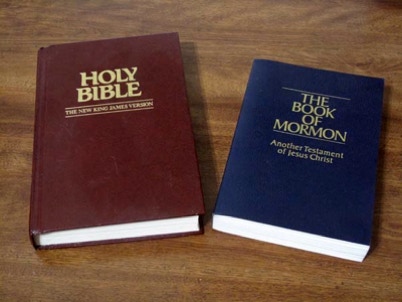
On Mormonism - Part 1

On The Book of Mormon - Part 1
Wednesday, August 25, 2010
Recently I happened to have a conversation with an acquaintance that is a member of the Church of Jesus Christ of Latter Day Saints, also known as Mormons. It was an interesting conversation as it was her intent to try and convert me to Mormonism. I didn’t bite. Instead, I challenged her on the truthfulness and veracity of Mormonism, but sadly she is very convinced of its divine origin and is not open to looking at the objective truth surrounding Joseph Smith and the beginnings of the Mormon faith. My sadness in this regard is further compounded by the fact that we have some good friends in common that are very steeped in the Mormon faith. One of them is serving as a Mormon missionary in Europe at this time, and she is proud that her son is currently on his two-year mission.
The purpose of this, and several blog entries to follow, is to examine Mormonism a bit. It is certainly not my intent to cover every single doctrinal issue, but rather to focus on the Book of Mormon itself. I want to ask and answer the question as to whether the Book of Mormon is divine revelation, or the product of Joseph Smith’s imagination.
My exposure to Mormonism began many years ago when as a teenager I visited their tent at the Lorain County Fair. During the course of our conversation I challenged the truthfulness and veracity of the Book of Mormon, and in response I was given a “challenge pamphlet.” This pamphlet challenged anyone who would question the divine nature of the Book of Mormon to write a comprehensive history of the nation of Tibet. This history had to be accurate, name people and places, and be verified by future science and findings. Only one who could write such a history would be worthy to question the Book of Mormon.
Now this is quite an interesting task. Note that this deflects the attention away from the Book of Mormon, and instead focuses ones attention on something not even related to the question. And of course, the underlying flaw and assumption in this approach is that the Book of Mormon is indeed accurate and truthful – something that needs to be established before being examined.
So is the Book of Mormon accurate? Can we with any degree of certainty conclude that major portions, if not all of the Book of Mormon, are verified by historical, archaeological, scientific, and geographical evidence?
Before tackling this question, let’s ask the same question of the Bible first, since both Mormons and Bible-believing Christians affirm that the Bible is the Word of God. Does the Bible measure up?
The answer is a resounding yes!
As one examines the Bible, it has been shown to be geographically accurate. When the Bible speaks of places and geographical features, it is without error. In fact, we are able with a great deal of certainty to identify and locate just about all of the geographical references in the Bible.
What about history? It has been shown that when the Bible speaks of historical facts, they are 100% accurate. The Bible speaks of Hittites, a group that many thought did not exist until someone dug up their main library. Several decades ago many said the Bible erred when it spoke of Belteshazzar as a king of Babylon, only to be proven wrong when bricks were dug up with his name on them. In fact, there is not a single geographical or historical error anywhere in the Bible, and furthermore most of the historical facts found in the Bible have been verified by external references.
What about science? Although the Bible is not a scientific book, when it does speak scientifically it is accurate. God revealed in the Old Testament that the life of the flesh is in the blood – long before Harvey made his discoveries of the importance of blood and the circulatory system. Job said the earth is turned as clay to the seal, a reference of the earth spinning on an axis. Isaiah speaks of God sitting on the sphere of the earth, and Solomon describes the hydrological cycle, something unknown till recently. Job says God hangs the earth on nothing, a reference to earth’s orbit, and God told Abraham in Genesis that he would have a seed as innumerable as the stars in the heavens, something not discovered till centuries later with the invention of the telescope.
How about prophecy? Again the Bible is shown to be 100% accurate. The Old Testament prophecies regarding Christ first coming were fulfilled accurately and to the letter in his first advent. The Old Testament talks about Tyre being a place where men dry their fishnets – something fulfilled many years later when Alexander the Great took the city stones of Tyre and threw them into the Mediterranean sea in order to reach the island fortress of Tyre. Today fishnets are dried on the ruins of the city that stretch out into the sea. In fact, every single prophecy made in the Old Testament regarding past events have proven to be completely accurate in every detail.
So the bottom line in regards to the Bible is that it is accurate. People, places, names, valleys, rivers, mountains, coins, empires, events, scientific facts, and cities mentioned in the Bible have been verified again and again. The Bible is true and accurate.
So having proven the Bible is accurate, let’s now apply the same tests to the Book of Mormon.
(to be continued in Part 2)
